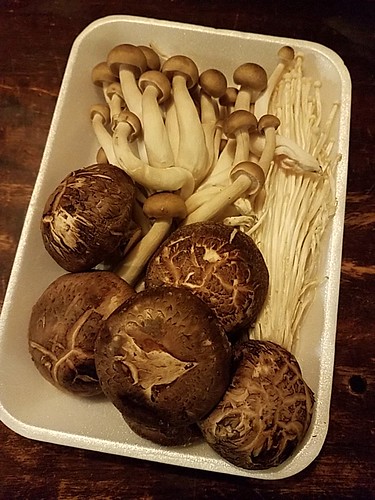Has been published for Brazil , despite the fact that birds are used as pets in all Latin American countries (e.g). The scarcity of information around the human processes involved in the classic activity of pajareros in Mexico urges a full description from the trade using an ethnoecological scheme . Ethnoecology may be the study from the indivisible triad made up in the program of beliefs (the kosmos), accumulated understanding (the corpus), and productive practices (the praxis) of social groups. Ethnoecological analysis tends to make it probable to comprehensively recognize the established relationships amongst social groups, the processes of interpretation and representation, plus the use or management of all-natural sources and their appropriation Consequently, as a way to deliver a complete view in the complexity from the interactions among cultures, natural resource appropriation, and nature itself, the ethnoecological method encompassing cosmovision, understanding, plus the utilization or management of all-natural sources have to be interdisciplinary and it should have a extensive holistic vision Nearby bird capturers and traders have rarely been studied from a scientific, neutral point of view in Latin America. A lot of the reports are offered by the organizations that happen to be considering impeding bird capture . NGOs have no interest in how the bird trade affects the ancestral traditions of neighborhood communities. We couldn’t identified any reports describing the ethnographic troubles of this activity in detail. Therefore, the goal of our present operate is usually to analyze the bird trade in Mexico making use of the components of an ethnoecology scheme.Three fieldtrips had been made during . The first trip was created to establish get in touch with with a important player, a pajareros leader; the second trip occurred in the course of May possibly to August, and also the third one particular occurred in December. A later week fieldtrip was produced through the summer season of ; this trip was primarily employed for interviewing girls in GW274150 web pajarero households and observing the practices involved within the capture, acclimation, maintenance, and nursing of birds. Ethnographic immersion .e spending time inside the pajarero households and conducting direct participatory observations , occurred inside the pajarero properties from localities in nine states of Mexico (Table); these  visits had been made during wild bird capture PubMed ID:https://www.ncbi.nlm.nih.gov/pubmed/26152414 within the cloud forests or grasslands, through bird sale in the fixed markets, streets, and ambulatory markets (tianguis), in the course of sporting events or religious ceremonies, and in the meetings in the associations (unions) of pajareros. Participatory observation involves social interaction using the informants in their contexts along with the acquisition of information inside a systematic and nonintrusive way . Throughout the ethnographic immersion, a field logbook , photographs and videotapes wereTable Localities visited for the duration of fieldtrips and interviews by stateState Ciudad de Mexico Quantity interviews Locality Chalco M ico City State of Mexico Cuautitl Ecatepec Jilotepec La ConchaC San Bartolo Morelos Tenancingo Guanajuato Hidalgo Jalisco Celaya Tulancingo Guadalajara Mexticac Tepatitl Puebla Amixtlan Chipaguatl Puebla capital Tlacotepec Quer aro San Juan del Rio Ciudad de Quer aro San Luis Potos Enramadas Santa Mar del R Veracruz Capulines Roca de Oro PP58 price TOTALMethod To understand the motivations and beliefs involved within the activities of the Mexican pajareros, we used qualitative research method
visits had been made during wild bird capture PubMed ID:https://www.ncbi.nlm.nih.gov/pubmed/26152414 within the cloud forests or grasslands, through bird sale in the fixed markets, streets, and ambulatory markets (tianguis), in the course of sporting events or religious ceremonies, and in the meetings in the associations (unions) of pajareros. Participatory observation involves social interaction using the informants in their contexts along with the acquisition of information inside a systematic and nonintrusive way . Throughout the ethnographic immersion, a field logbook , photographs and videotapes wereTable Localities visited for the duration of fieldtrips and interviews by stateState Ciudad de Mexico Quantity interviews Locality Chalco M ico City State of Mexico Cuautitl Ecatepec Jilotepec La ConchaC San Bartolo Morelos Tenancingo Guanajuato Hidalgo Jalisco Celaya Tulancingo Guadalajara Mexticac Tepatitl Puebla Amixtlan Chipaguatl Puebla capital Tlacotepec Quer aro San Juan del Rio Ciudad de Quer aro San Luis Potos Enramadas Santa Mar del R Veracruz Capulines Roca de Oro PP58 price TOTALMethod To understand the motivations and beliefs involved within the activities of the Mexican pajareros, we used qualitative research method
s. Qualitative strategies render descriptive information, such as the words used by individuals, their obse.Has been published for Brazil , despite the  fact that birds are applied as pets in all Latin American countries (e.g). The scarcity of facts around the human processes involved in the standard activity of pajareros in Mexico urges a total description of your trade employing an ethnoecological scheme . Ethnoecology is definitely the study with the indivisible triad created up from the technique of beliefs (the kosmos), accumulated knowledge (the corpus), and productive practices (the praxis) of social groups. Ethnoecological evaluation makes it feasible to comprehensively recognize the established relationships between social groups, the processes of interpretation and representation, as well as the use or management of all-natural resources and their appropriation Consequently, in an effort to deliver a complete view on the complexity from the interactions among cultures, organic resource appropriation, and nature itself, the ethnoecological strategy encompassing cosmovision, understanding, as well as the utilization or management of natural resources has to be interdisciplinary and it should have a complete holistic vision Local bird capturers and traders have rarely been studied from a scientific, neutral point of view in Latin America. The majority of the reports are provided by the organizations which are keen on impeding bird capture . NGOs have no interest in how the bird trade impacts the ancestral traditions of local communities. We couldn’t located any reports describing the ethnographic challenges of this activity in detail. Consequently, the objective of our present function would be to analyze the bird trade in Mexico employing the elements of an ethnoecology scheme.3 fieldtrips had been made during . The very first trip was made to establish contact having a important player, a pajareros leader; the second trip occurred during Could to August, plus the third one particular occurred in December. A later week fieldtrip was produced throughout the summer season of ; this trip was mainly applied for interviewing ladies in pajarero households and observing the practices involved inside the capture, acclimation, maintenance, and nursing of birds. Ethnographic immersion .e spending time within the pajarero households and conducting direct participatory observations , occurred in the pajarero houses from localities in nine states of Mexico (Table); these visits were produced throughout wild bird capture PubMed ID:https://www.ncbi.nlm.nih.gov/pubmed/26152414 inside the cloud forests or grasslands, throughout bird sale within the fixed markets, streets, and ambulatory markets (tianguis), for the duration of sporting events or religious ceremonies, and within the meetings with the associations (unions) of pajareros. Participatory observation involves social interaction using the informants in their contexts as well as the acquisition of information within a systematic and nonintrusive way . Throughout the ethnographic immersion, a field logbook , photographs and videotapes wereTable Localities visited during fieldtrips and interviews by stateState Ciudad de Mexico Quantity interviews Locality Chalco M ico City State of Mexico Cuautitl Ecatepec Jilotepec La ConchaC San Bartolo Morelos Tenancingo Guanajuato Hidalgo Jalisco Celaya Tulancingo Guadalajara Mexticac Tepatitl Puebla Amixtlan Chipaguatl Puebla capital Tlacotepec Quer aro San Juan del Rio Ciudad de Quer aro San Luis Potos Enramadas Santa Mar del R Veracruz Capulines Roca de Oro TOTALMethod To know the motivations and beliefs involved within the activities in the Mexican pajareros, we made use of qualitative research strategy
fact that birds are applied as pets in all Latin American countries (e.g). The scarcity of facts around the human processes involved in the standard activity of pajareros in Mexico urges a total description of your trade employing an ethnoecological scheme . Ethnoecology is definitely the study with the indivisible triad created up from the technique of beliefs (the kosmos), accumulated knowledge (the corpus), and productive practices (the praxis) of social groups. Ethnoecological evaluation makes it feasible to comprehensively recognize the established relationships between social groups, the processes of interpretation and representation, as well as the use or management of all-natural resources and their appropriation Consequently, in an effort to deliver a complete view on the complexity from the interactions among cultures, organic resource appropriation, and nature itself, the ethnoecological strategy encompassing cosmovision, understanding, as well as the utilization or management of natural resources has to be interdisciplinary and it should have a complete holistic vision Local bird capturers and traders have rarely been studied from a scientific, neutral point of view in Latin America. The majority of the reports are provided by the organizations which are keen on impeding bird capture . NGOs have no interest in how the bird trade impacts the ancestral traditions of local communities. We couldn’t located any reports describing the ethnographic challenges of this activity in detail. Consequently, the objective of our present function would be to analyze the bird trade in Mexico employing the elements of an ethnoecology scheme.3 fieldtrips had been made during . The very first trip was made to establish contact having a important player, a pajareros leader; the second trip occurred during Could to August, plus the third one particular occurred in December. A later week fieldtrip was produced throughout the summer season of ; this trip was mainly applied for interviewing ladies in pajarero households and observing the practices involved inside the capture, acclimation, maintenance, and nursing of birds. Ethnographic immersion .e spending time within the pajarero households and conducting direct participatory observations , occurred in the pajarero houses from localities in nine states of Mexico (Table); these visits were produced throughout wild bird capture PubMed ID:https://www.ncbi.nlm.nih.gov/pubmed/26152414 inside the cloud forests or grasslands, throughout bird sale within the fixed markets, streets, and ambulatory markets (tianguis), for the duration of sporting events or religious ceremonies, and within the meetings with the associations (unions) of pajareros. Participatory observation involves social interaction using the informants in their contexts as well as the acquisition of information within a systematic and nonintrusive way . Throughout the ethnographic immersion, a field logbook , photographs and videotapes wereTable Localities visited during fieldtrips and interviews by stateState Ciudad de Mexico Quantity interviews Locality Chalco M ico City State of Mexico Cuautitl Ecatepec Jilotepec La ConchaC San Bartolo Morelos Tenancingo Guanajuato Hidalgo Jalisco Celaya Tulancingo Guadalajara Mexticac Tepatitl Puebla Amixtlan Chipaguatl Puebla capital Tlacotepec Quer aro San Juan del Rio Ciudad de Quer aro San Luis Potos Enramadas Santa Mar del R Veracruz Capulines Roca de Oro TOTALMethod To know the motivations and beliefs involved within the activities in the Mexican pajareros, we made use of qualitative research strategy
s. Qualitative strategies render descriptive data, including the words utilized by folks, their obse.
http://cathepsin-s.com
Cathepsins
